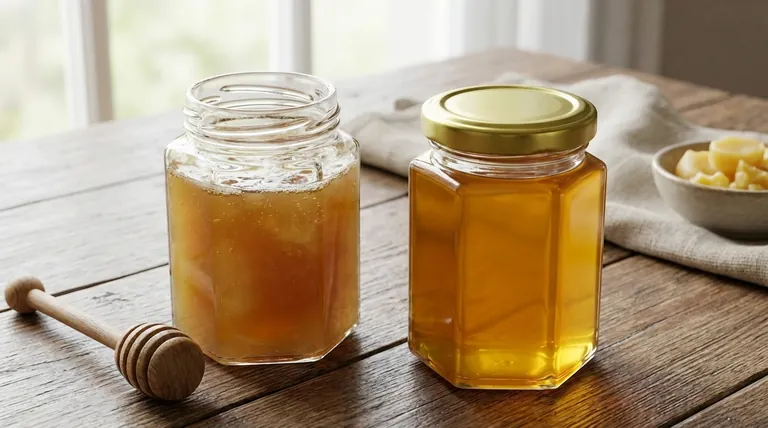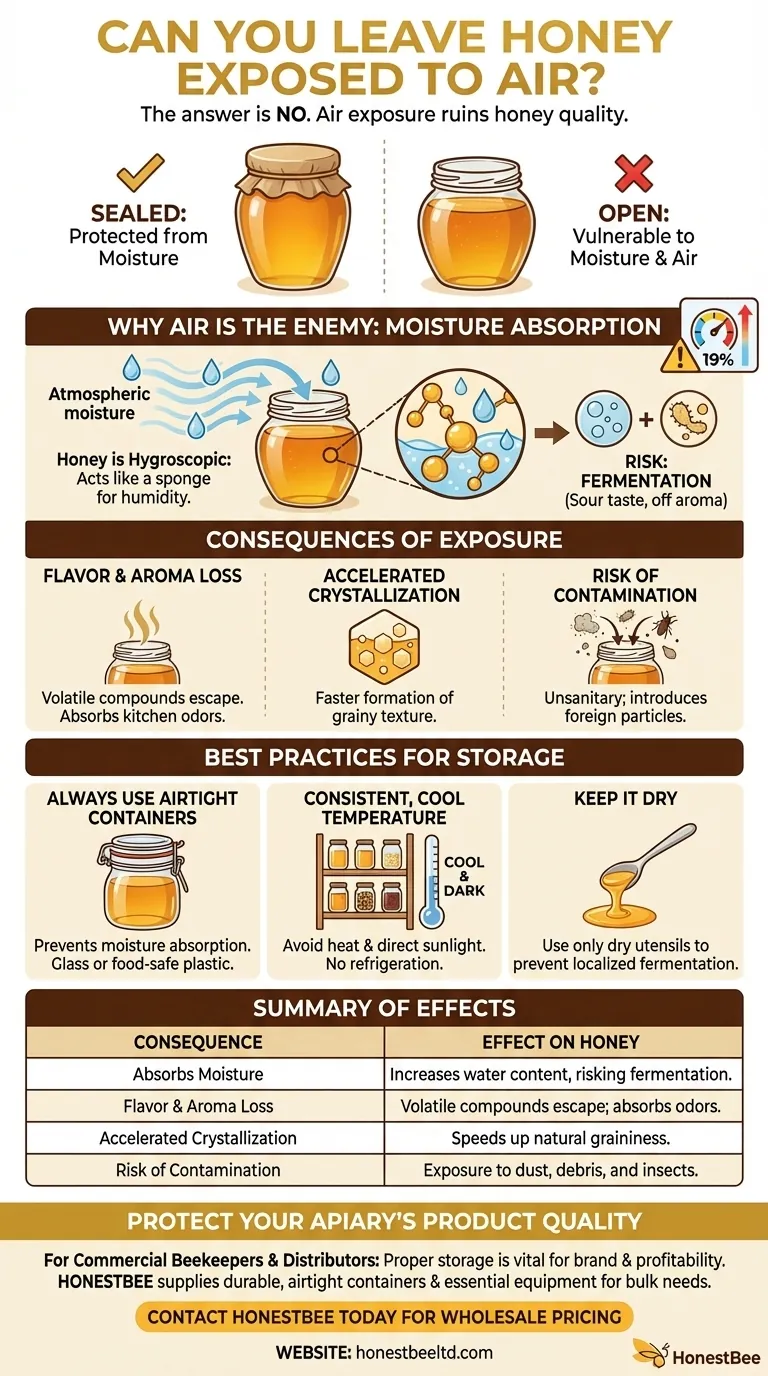No, you should not leave honey exposed to air for extended periods. While honey is incredibly stable, its greatest vulnerability is moisture. Open exposure allows honey, which is naturally low in water, to absorb humidity directly from the atmosphere, which degrades its quality and can eventually lead to spoilage.
The core issue isn't air itself, but the moisture it carries. Honey's remarkable shelf life is due to its low water content, and leaving it unsealed allows it to absorb atmospheric moisture, which compromises its stability and can cause it to ferment.

Why Air Exposure Is a Problem for Honey
To understand why an open jar is a problem, you must first understand what makes honey so resilient. Its stability is a delicate balance that air and moisture disrupt.
Honey's Natural Defense: High Sugar, Low Water
Honey is a supersaturated sugar solution with very low water content, typically below 18%. This creates an environment with such high osmotic pressure that it dehydrates and kills most bacteria and other microbes, acting as a natural preservative.
The Role of Humidity
Honey is hygroscopic, meaning it actively attracts and absorbs water from its surroundings. When left open to the air, it acts like a sponge for atmospheric humidity, steadily increasing its internal water content.
The Risk of Fermentation
The primary risk of increased water content is fermentation. Honey contains natural, dormant osmophilic yeasts. Once the water content rises above approximately 19%, these yeasts can become active, metabolizing the sugars and producing alcohol and carbon dioxide. This results in a sour taste, a bubbly appearance, and an "off" aroma, effectively spoiling the honey.
Understanding the Trade-offs and Consequences
Exposing honey to air does more than just risk fermentation. It causes a gradual decline in the very qualities that make honey desirable.
Degradation of Flavor and Aroma
An open container not only allows moisture in but also lets the delicate, volatile aromatic compounds that define a honey's unique flavor profile escape. Furthermore, honey can absorb other strong odors from your kitchen, tainting its taste.
Accelerated Crystallization
While crystallization is a natural process and not a sign of spoilage, temperature fluctuations and exposure to particles in the air can speed it up. The texture changes from a smooth liquid to a semi-solid, grainy state. While perfectly edible, many find this texture less desirable.
Risk of Contamination
An unsealed container is an open invitation for dust, debris, and insects. This introduces foreign materials that contaminate the honey and are unsanitary.
Best Practices for Honey Storage
Proper storage is simple and preserves the quality and safety of your honey indefinitely. The goal is to protect it from its two main enemies: moisture and heat.
Always Use an Airtight Container
This is the most critical step. A tightly sealed lid prevents the honey from absorbing atmospheric moisture. The original container is usually best, but any glass jar or food-safe plastic container with a secure lid will work. Avoid storing honey in unlined metal containers, as the honey's natural acidity can cause the metal to oxidize over time.
Maintain a Consistent, Cool Temperature
Store honey at a steady room temperature, ideally in a cool, dark place like a pantry or cupboard. Keep it away from direct sunlight and heat sources like stoves or ovens, as heat can degrade its flavor and darken its color. There is no need to refrigerate honey; in fact, cold temperatures will significantly accelerate crystallization.
Keep It Dry
Always use a dry spoon when scooping honey from the jar. Introducing even a small amount of water from a wet utensil can create a localized spot with high enough moisture to initiate fermentation.
Making the Right Choice for Your Honey
Your storage strategy should align with your goal, whether it's long-term preservation or daily use.
- If your primary focus is long-term preservation: Store the honey in a tightly sealed, airtight container in a cool, dark pantry to protect its quality for years.
- If your primary focus is daily convenience: It is acceptable to keep the jar on the counter, but ensure the lid is sealed tightly immediately after each use.
- If you discover your honey has crystallized: Simply place the sealed jar in a bowl of warm (not boiling) water and stir gently until the crystals dissolve.
Protecting your honey's integrity is as simple as keeping the lid on.
Summary Table:
| Consequence of Air Exposure | Effect on Honey |
|---|---|
| Absorbs Moisture | Increases water content, risking fermentation. |
| Flavor & Aroma Loss | Volatile compounds escape; absorbs outside odors. |
| Accelerated Crystallization | Speeds up natural graininess. |
| Risk of Contamination | Exposure to dust, debris, and insects. |
Protect Your Apiary's Product Quality with Proper Storage Solutions
As a commercial beekeeper or distributor, the quality of your honey directly impacts your brand and profitability. Proper storage is the first line of defense against spoilage and quality degradation. HONESTBEE supplies the durable, airtight containers and essential beekeeping equipment that commercial apiaries and distributors need to safeguard their honey from harvest to sale.
We understand the challenges of large-scale operations. Our wholesale-focused approach ensures you get the reliable, high-quality supplies necessary to maintain product integrity and maximize shelf life.
Ensure every batch meets your high standards. Contact HONESTBEE today to discuss your equipment needs and wholesale pricing.
Visual Guide

Related Products
- Hexagonal Glass Honey Jars with Metal Lug Caps Elegant Versatile Packaging
- Classic Drum Shaped Glass Honey Jar with Airtight Lid
- Inverted Squeezable Honey Jar with No Drip Flip Top Cap for Easy Pouring
- Plastic Honey Gate Spout with Wing Nut for Beekeeping Honey Bucket
- High Quality Honey Dehumidifier Dryer Thickening Machine for Beekeeping
People Also Ask
- What factors should be considered when choosing honey packaging? Optimize for Brand, Operations & Market
- What is the term for honey can absorb moisture from the air? Understanding Hygroscopy
- How should honey be stored and packaged? Preserve Flavor & Quality with Proper Containers
- What are the advantages of using glass jars for honey packaging? Preserve Purity & Elevate Your Brand
- What are the common types of honey packaging? A Guide to Glass, Plastic, Pouches & Tins



















